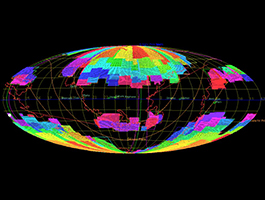Misión de la ESA para estudiar el «lado oscuro» del Universo supera una prueba importante

In 2020, the European Space Agency (ESA) will launch Euclid, an ambitious mission to map the shapes and positions of two billion galaxies across more than a third of the sky. Euclid will provide new insights into the properties of dark matter and dark energy, thus shedding light on the formation and evolution of the Universe. The first step towards Euclid's launch was taken last week, with the approval of the so-called preliminary design review (PDR), in which a team of researchers from the Institute of Astrophysics and Space Sciences (IA), in Portugal, were involved. By passing its PDR, there is confidence that the Euclid mission spacecraft and instruments can be built. In ESA's words, it's time to start "cutting metal."
The work of the IA team consisted of “the delivery of a complete observation plan for the six-year lifetime of the mission, demonstrating that it is possible to survey more than one third of the sky with the required quality and achieve the primary science objectives of the mission,” reports Ismael Tereno, coordinator of the team. The test demonstrated that the combined performance of the spacecraft, telescope, and instruments can indeed deliver the unprecedented amount of data required to fulfill Euclid’s scientific goals.
António da Silva, board member of the Euclid consortium and Portuguese coordinator in the project explains that, “This contribution is part of the responsibilities assigned to Portugal in the consortium, and allows Portuguese researchers access to the proprietary data of this important mission.” And he adds, “The quality of the team’s work was widely acknowledged by the consortium, which underscores the high level of internationalization of this area of research in Portugal.”
Portugal joined the Euclid consortium in 2012, via a multilateral agreement signed by FCT. The funding agency sits on the Steering Committee of the consortium, which today has scientists from 14 European countries (Austria, Belgium, Denmark, France, Finland, Germany, Italy, the Netherlands, Norway, Portugal, Romania, Spain, Switzerland, and the UK) as well as a number of US scientists, including 40 nominated by NASA. Portugal itself has around 20 scientists in the consortium, from different institutions, coordinated by the IA.
Dark matter and dark energy are thought to make up most of the matter and energy in the Universe. Indeed, normal atoms account for less than 5% of matter in the Universe. The “dark side” of the Universe cannot be seen however, but only inferred: dark matter is inferred from measurements of alignments in the orientations of distant galaxies; dark energy accounts for the rate of the Universe’s expansion as traced by galaxies’ distribution in space. Thus, by mapping two billion galaxies at unparalleled accuracy, Euclid will allow astronomers to grasp the properties and behavior of dark matter and dark energy as well as the mystery of the Universe’s recent expansion.
 Euclid was first proposed to ESA in 2007, selected as the second medium-class mission of the space agency in 2011, and formally adopted in 2012 (the year Portugal joined the consortium). The mission will launch in December 2020 on a Soyuz rocket from Europe’s Spaceport in Kourou, French Guiana, and will orbit at 1.5 million km from Earth. With the PDR review safely completed, the next major milestone will be in two years, for the critical design review, after which, if all goes well, Euclid will be assembled.
Euclid was first proposed to ESA in 2007, selected as the second medium-class mission of the space agency in 2011, and formally adopted in 2012 (the year Portugal joined the consortium). The mission will launch in December 2020 on a Soyuz rocket from Europe’s Spaceport in Kourou, French Guiana, and will orbit at 1.5 million km from Earth. With the PDR review safely completed, the next major milestone will be in two years, for the critical design review, after which, if all goes well, Euclid will be assembled.
The four IA researchers on the Euclid Sky Survey Working Group (ESSWG) are: António da Silva (IA and Faculty of Sciences, University of Lisbon), Ismael Tereno (IA and FCUL), João Dinis (IA and FCUL), and Carla Sofia Carvalho (IA). – FCUL) , Ismael Tereno (IA and FCUL), João Dinis (IA and FCUL) and Carla Sofia Carvalho (IA).
Images, from top to bottom:
- The sky mapped by Euclid.
- Artist's impression of the Euclid spacecraft
(Credits: ESSWG, IA, and ESA)